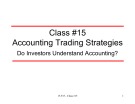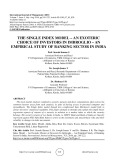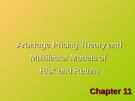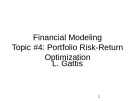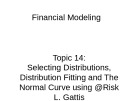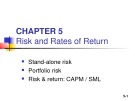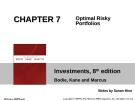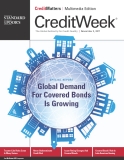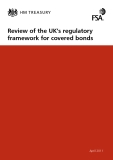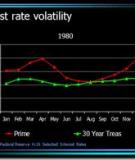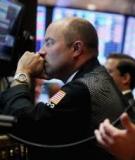
Risk free return
-
Geopolitical events are expected to affect all countries, asset classes, and sectors. Vietnam is a large open economy, actively participating in a vast network of free trade agreements. This study will give a better overview of the relationship between GPR and stock return’s spillover in the Vietnamese stock market considering data from a variety of industries.
 11p
11p  vijeff
vijeff
 30-11-2023
30-11-2023
 5
5
 4
4
 Download
Download
-
Lecture Class #15: Accounting trading strategies. After studying this section will help you understand: A high stock return (relative to other stocks) does not immediately imply you are getting a “free lunch” or an arbitrage opportunity exists.
 15p
15p  huangminghao_1902
huangminghao_1902
 27-02-2022
27-02-2022
 15
15
 1
1
 Download
Download
-
This paper attempts to identify and explain the simple linear regression aspects of returns of a security in relation to a market index to which the security belongs.
 13p
13p  murielnguyen
murielnguyen
 25-06-2020
25-06-2020
 14
14
 4
4
 Download
Download
-
In chapter 8 we discussed optimal risky portfolios. That decision governs how an investor chooses between risk-free assets and “the” optimal portfolio of risky assets. This chapter explains how to construct that optimal risky portfolio. We begin with a discussion of how diversification can reduce the variability of portfolio returns. After establishing this basic point, we examine efficient diversification strategies at the asset allocation and security selection levels.
 22p
22p  nanhankhuoctai1
nanhankhuoctai1
 29-05-2020
29-05-2020
 21
21
 2
2
 Download
Download
-
In the previous chapters on risk and return relationships, we have treated securities at a high level of abstraction. We assumed implicitly that a prior, detailed analysis of each security already had been performed, and that its risk and return features had been assessed. in this chapter, we turn now to specific analyses of particular security markets. We examine valuation principles, determinants of risk and return, and portfolio strategies commonly used within and across the various markets.
 19p
19p  nanhankhuoctai1
nanhankhuoctai1
 29-05-2020
29-05-2020
 22
22
 2
2
 Download
Download
-
Lecture Investments (6/e) - Chapter 7 "Capital allocation between the risky and the risk-free asset" presents the following content: allocating capital - risky & risk free assets, expected returns for combinations, possible combinations, variance for possible combined portfolios, combinations without leverage,...
 14p
14p  nanhankhuoctai1
nanhankhuoctai1
 29-05-2020
29-05-2020
 12
12
 1
1
 Download
Download
-
Chapter 11, Arbitrage pricing theory and multifactor models of risk and return. In this chapter, we show how such no-arbitrage conditions together with the factor model introduced in Chapter 10 allow us to generalize the security market line of the CAPM to gain richer insight into the risk-return relationship.
 13p
13p  nanhankhuoctai1
nanhankhuoctai1
 29-05-2020
29-05-2020
 15
15
 0
0
 Download
Download
-
Lecture Financial modeling - Topic 4: Portfolio risk-return optimization. In this chapter students will compute optimal portfolio weights that combine risky portfolios and risk free assets, compute efficient (max return/min risk) and optimal risky portfolios, compute optimal complete portfolios that combine a risk free asset or borrowing.
 22p
22p  shiwo_ding8
shiwo_ding8
 25-06-2019
25-06-2019
 18
18
 1
1
 Download
Download
-
Topic 15 - Building stochastic free cash flow and DCF models using excel and @Risk. After completing this unit, you should be able to: Forecast and simulate free cash flows, value common stock using discounted cash flow, use other distributional assumptions in @Risk to create stochastic DCF models.
 17p
17p  shiwo_ding8
shiwo_ding8
 25-06-2019
25-06-2019
 23
23
 2
2
 Download
Download
-
Topic 14 - Selecting distributions, distribution fitting and the normal curve using @Risk. After completing this unit, you should be able to: Select distributions other than the normal distribution, simulate portfolio returns and free cash flows by fitting a distribution, insert distributions using @Risk menu.
 23p
23p  shiwo_ding8
shiwo_ding8
 25-06-2019
25-06-2019
 25
25
 1
1
 Download
Download
-
Chapter 5: Risk and rates of return. This chapter presents the following content: Investment returns, what is investment risk?, probability distributions, investment alternatives, Why is the T-bill return independent of the economy? Do T-bills promise a completely risk-free return? How do the returns of HT and Coll. behave in relation to the market?...
 50p
50p  hihihaha8
hihihaha8
 10-04-2017
10-04-2017
 51
51
 2
2
 Download
Download
-
In this chapter, we first motivate the discussion by illustrating the potential gains from simple diversification into many assets. We then proceed to examine the process of efficient diversification from the ground up, starting with an investment menu of only two risky assets, then adding the risk-free asset, and finally, incorporating the entire universe of available risky securities. We learn how diversification can reduce risk without affecting expected returns.
 38p
38p  tangtuy18
tangtuy18
 12-07-2016
12-07-2016
 56
56
 3
3
 Download
Download
-
Asymmetric and flawed incentives that favor risk hiding in the tails. There were three primary flaws in the compensation methods that led to artificial earnings and not adequately and appropriately risk-adjusted compensation. They are a) asymmetric payoff: upside, limited, or no economic downside (a free or underpriced option); b) flawed frequency: annual compensation for risks that blow-up every few years, with absence of claw-back provisions; and c) misattribution: compensation for returns that are an attribute of the market (e.g.
 25p
25p  doipassword
doipassword
 01-02-2013
01-02-2013
 29
29
 3
3
 Download
Download
-
After the occurrence of a natural disaster, the reconstruction can be financed with catastrophe bonds (CAT bonds) or reinsurance. For insurers, reinsurers and other corporations CAT bonds are hedging instruments that offer multi year pro- tection without the credit risk present in reinsurance by providing full collateral for the risk limits offered throught the transaction. For investors CAT bonds offer attractive returns and reduction of portfolio risk, since CAT bonds defaults are uncorrelated with defaults of other securities. Baryshnikov et al.
 62p
62p  enter1cai
enter1cai
 16-01-2013
16-01-2013
 60
60
 4
4
 Download
Download
-
In total, the model can generate expected excess corporate bond returns in four ways. First, through the dependence of credit spreads (or, equivalently, default intensities) on default-free term structure factors. Second, because the risk of common or systematic changes in credit spreads across firms is priced. Third, via a risk premium on firm-specific credit spread changes, and, fourth, due to a risk premium on the default jump. 1 Empirically, we find that all these terms contribute to the expected excess corporate bond return, except for the risk of firm-specific credit spread changes.
 51p
51p  enter1cai
enter1cai
 16-01-2013
16-01-2013
 38
38
 5
5
 Download
Download
-
We identify and estimate the sources of risk that cause corporate bonds to earn an excess return over default-free bonds. In particular, we estimate the risk premium associated with a default event. Default is modelled using a jump process with stochastic intensity. For a large set of firms, we model the default intensity of each firm as a function of common and firm-specific factors. In the model, corporate bond excess returns can be due to risk premia on factors driving the intensities and due to a risk premium on the default jump risk.
 223p
223p  enter1cai
enter1cai
 16-01-2013
16-01-2013
 40
40
 5
5
 Download
Download
-
Given the extensive literature on risk premia in equity markets, relatively little is known about expected returns and risk premia in the corporate bond market. Recent empirical evidence by Elton et al. (2001) suggests that corporate bonds earn an expected excess return over default-free government bonds, even after correcting for the likelihood of default and tax differences. As shown by Elton et al. (2001), part of this expected excess return is due to the fact that changes in credit spreads (if no default occurs) are systematic, implying that the risk of these changes should be priced.
 87p
87p  enter1cai
enter1cai
 16-01-2013
16-01-2013
 71
71
 4
4
 Download
Download
-
For the data presented on the Bank’s website, the nominal government spot interest rate for n years refers to the interest rate applicable today (‘spot’) on an n year risk-free nominal loan. It is the rate at which an individual nominal cash flow on some future date is discounted to determine its present value. By definition it would be the yield to maturity of a nominal zero coupon bond3 and can be considered as an average of single period rates to that maturity.
 27p
27p  taisaocothedung
taisaocothedung
 09-01-2013
09-01-2013
 53
53
 2
2
 Download
Download
-
Because both nondurable and durable consumption are smooth, the durable consumption model requires high risk aversion to fit the high level and volatil- ity of expected stock returns. This paper shows that the model can successfully explain the cross-sectional and time variation in expected stock returns, con- ditional on an “equity premium puzzle” (Mehra and Prescott (1985)). The high risk aversion does not imply a “risk-free rate puzzle” (Weil (1989)) in the model because recursive utility allows the EIS to be higher than the inverse of risk aversion....
 61p
61p  bocapchetnguoi
bocapchetnguoi
 05-12-2012
05-12-2012
 84
84
 3
3
 Download
Download
-
The argument that pension funds should only assume a risk-free rate of return in assessing pension fund adequacy ignores the distinction between governmental units, which need be little concerned over the timing of market fluctuations, and individual investors, who must be very sensitive to market timing. This argument also fails to recognize the fact that over a long period, future stock returns are inversely related to current price-to-earnings (PE) ratios.
 20p
20p  quaivattim
quaivattim
 04-12-2012
04-12-2012
 50
50
 3
3
 Download
Download
CHỦ ĐỀ BẠN MUỐN TÌM










